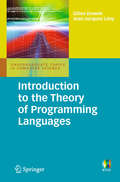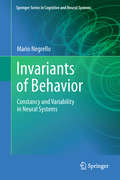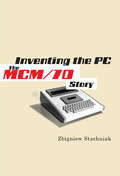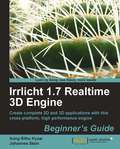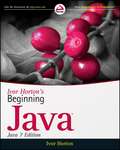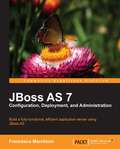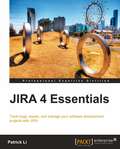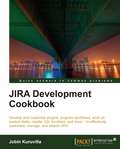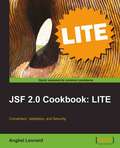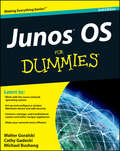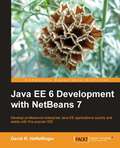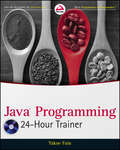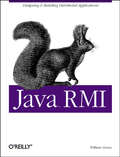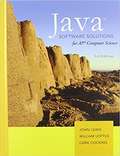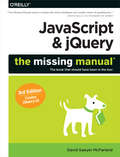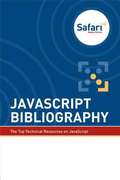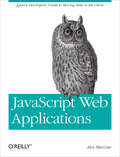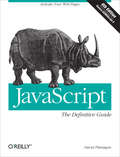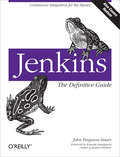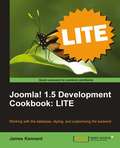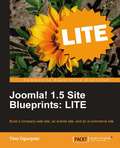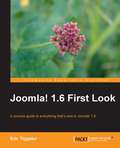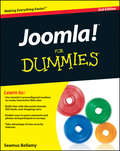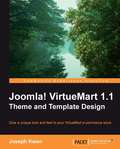- Table View
- List View
Introduction to the Theory of Programming Languages
by Jean-Jacques Lévy Gilles DowekThe design and implementation of programming languages, from Fortran and Cobol to Caml and Java, has been one of the key developments in the management of ever more complex computerized systems. Introduction to the Theory of Programming Languages gives the reader the means to discover the tools to think, design, and implement these languages. It proposes a unified vision of the different formalisms that permit definition of a programming language: small steps operational semantics, big steps operational semantics, and denotational semantics, emphasising that all seek to define a relation between three objects: a program, an input value, and an output value. These formalisms are illustrated by presenting the semantics of some typical features of programming languages: functions, recursivity, assignments, records, objects, ... showing that the study of programming languages does not consist of studying languages one after another, but is organized around the features that are present in these various languages. The study of these features leads to the development of evaluators, interpreters and compilers, and also type inference algorithms, for small languages.
Invariants of Behavior
by Mario NegrelloThe study of the brain and behavior is illuminated with the discovery of invariances. Experimental brain research uncovers constancies amidst variation, with respect to interventions and transformations prescribed by experimental paradigms. Place cells, mirror neurons, event related potentials and areas differentially active in fMRI, all illustrate the pervasive role of invariances in neural systems in relation to their function.
Inventing the PC
by Zbigniew StachniakInventing the PC details the invention and design of the MCM/70 computer and the prolonged struggle to bring it to market. Zbigniew Stachniak offers an insider's view of events on the front lines of pioneering work on personal computers. He shows what information and options PC pioneers had, how well they understood what they were doing, and how that understanding - or lack thereof - shaped both their engineering ingenuity and the indecisiveness and over-reaching ambition that would ultimately turn a very promising venture into a missed opportunity. Providing comprehensive historical background and rich photographic documentation, Inventing the PC tells the story of a Canadian company on the cutting-edge of the information age.
Inventing the PC: The MCM/70 Story
by Zbigniew StachniakInventing the PC details the invention and design of the MCM/70 computer and the prolonged struggle to bring it to market. Zbigniew Stachniak offers an insider's view of events on the front lines of pioneering work on personal computers. He shows what information and options PC pioneers had, how well they understood what they were doing, and how that understanding - or lack thereof - shaped both their engineering ingenuity and the indecisiveness and over-reaching ambition that would ultimately turn a very promising venture into a missed opportunity. Providing comprehensive historical background and rich photographic documentation, Inventing the PC tells the story of a Canadian company on the cutting-edge of the information age.
Irrlicht 1.7 Realtime 3D Engine Beginner's Guide
by Aung Sithu Kyaw Johannes SteinA beginner's guide with plenty of screenshots and explained code. If you have C++ skills and are interested in learning Irrlicht, this book is for you. Absolutely no knowledge of Irrlicht is necessary for you to follow this book!
Ivor Horton's Beginning Java
by Ivor HortonFind out why thousands have turned to Ivor Horton for learning JavaIvor Horton's approach is teaching Java is so effective and popular that he is one of the leading authors of introductory programming tutorials, with over 160,000 copies of his Java books sold. In this latest edition, whether you're a beginner or an experienced programmer switching to Java, you'll learn how to build real-world Java applications using Java SE 7. The author thoroughly covers the basics as well as new features such as extensions and classes; extended coverage of the Swing Application Framework; and he does it all in his unique, highly accessible style that beginners love.Provides a thorough introduction to the latest version of the Java programming language, Java SE 7Introduces you to a host of new features for both novices and experienced programmersCovers the basics as well as new language extensions and classes and class methodsGuides you through the Swing Application Framework for creating Swing appsUses numerous step-by-step programming examples to guide you through the development processThere's no better way to get thoroughly up to speed on the latest version of Java than with Ivor Horton's latest, comprehensive guide.
JBoss AS 7 Configuration, Deployment and Administration
by Francesco MarchioniThis is a step-by-step book that builds on your knowledge by adding to an example game over the course of each chapter. Each topic uses example code that can be compiled and tested to show how things work instead of just telling you. Complicated tasks are broken down into easy to follow steps with clear explanations of what each line of code is doing. This book is written for beginners to UnrealScript, whether this is your first experience with programming or you're coming into it from another language and would like to learn how UnrealScript uses concepts you're already familiar with. If you would like to make games with the Unreal Development Kit, this book is for you.
JIRA 4 Essentials
by Patrick LiThis book is a step-by-step tutorial and is packed with practical examples that will make learning JIRA easy.If you want to get started with JIRA, then this is the perfect book for you. You will need to be familiar with basic computer knowledge for your or your organization's standard operating environment and to have experience with software project management.
JIRA Development Cookbook
by Jobin KuruvillaThis book is part of Packt's Cookbook series. A Packt Cookbook contains step-by-step recipes for solutions to the most important problems you face when working with a topic. Inside this Cookbook you will find: A straightforward and easy-to-follow format, A selection of the most important tasks and problems ,Carefully organized instructions for solving the problem efficiently, Clear explanations of what you did Details for applying the solution to other situations If you are a JIRA developer or project manager who wants to fully exploit the exciting capabilities of JIRA, then this is the perfect book for you.
JSF 2.0 Cookbook: LITE
by Anghel LeonardPractical, hands-on "Cookbook" approach. Full of clear, step-by-step instructions that you can apply straight away. Written for people who want to get maximum results without lots of background and theory reading. JSF developers who want to work with validators, converters and security features of JSF. You don't need any prior knowledge of JSF to use these recipes.
JUNOS OS For Dummies
by Michael Bushong Walter J. Goralski Cathy GadeckiLearn to use JUNOS to make your network reliable!Providing network administrators with a reliable network operating system, JUNOS software is an award-winning network operating system that focuses on security and the avoidance of down time. This easy-to-understand book starts with the basics of JUNOS and walks you through its features so that you can quickly learn how to set up, operate, and add key services.Since the various JUNOS features are constantly being updated to provide your network with the best security possible, this new edition shares must-know information, helpful advice, handy tips, and essential cautions for working with JUNOS. Plus, you'll find out how to set up a routing protocol that automates configuration of routing tables for greater efficiency and how you can set up individual or group user accounts locally on the route, or on remote centralized authentication servers.Starts with the basics and introduces you to JUNOSExplains how to connect, manage, and troubleshoot routers and other Juniper appliancesOffers tips for making your network more efficient and reveals essential cautionsWalks you through setting up, operating, and adding key servicesDetails ways to configure JUNOS default security features as well as restricted physical access to protect routersBreaks down advanced concepts into easy-to-understand segments so you can build your knowledge graduallyThis new edition gets you started using the sophisticated features and techniques of JUNOS today.
Java EE 6 Development with NetBeans 7
by David R. HeffelfingerThe book is a practical guide explaining the various features of the NetBeans IDE related to enterprise application development. The book is aimed at Java developers who wish to develop Java EE applications while taking advantage of NetBeans functionality to automate repetitive tasks and to ease their software development efforts. Familiarity with NetBeans or Java EE is not assumed.
Java Programming
by Yakov FainA unique book-and-video package presented by Java guru Yakov Fain As one of the most popular software languages for building Web applications, Java is often the first programming language developers learn. The latest version includes numerous updates that both novice and experienced developers need to know. With this invaluable book-and-video package, Java authority Yakov Fain fully covers Java?s new features as well as its language extensions, classes and class methods, and the Swing Application Framework. For each lesson that he discusses in the book, there is an accompanying instructional video to reinforce your learning experience. Lessons include: Introducing Java Eclipse IDE Object-Oriented Programming Class Methods Back to Java Basics Packages, Interfaces, and Encapsulation Programming with Abstract Classes and Interfaces Introducing the Graphic User Interface Event Handling in UI Introduction to Java Applets Developing a Tic-Tac-Toe Applet Developing a Ping-Pong Game Error Handling Introduction to Collections Introduction to Generics Working with Streams Java Serialization Network Programming Processing E-Mails with Java Introduction to Multi-Threading Digging Deeper into Concurrent Execution Working with Databases Using JDBC Swing with JTable Annotations and Reflection Remote Method Invocation Java EE 6 Overview Programming with Servlets JavaServer Pages Developing Web Applications with JSF Introducing JMS and MOM Introducing JNDI Introduction to Enterprise JavaBeans Introduction to the Java Persistence API Working with RESTful Web Services Introduction to Spring MVC Framework Introduction to Hibernate Framework Bringing JavaFX to the Mix Java Technical Interviews Note: As part of the print version of this title, video lessons are included on DVD. For e-book versions, video lessons can be accessed at wrox. com using a link provided in the interior of the e-book. ?
Java RMI: Designing & Building Distributed Applications
by William GrossoJava RMI contains a wealth of experience in designing and implementing Java's Remote Method Invocation. If you're a novice reader, you will quickly be brought up to speed on why RMI is such a powerful yet easy to use tool for distributed programming, while experts can gain valuable experience for constructing their own enterprise and distributed systems.With Java RMI, you'll learn tips and tricks for making your RMI code excel. The book also provides strategies for working with serialization, threading, the RMI registry, sockets and socket factories, activation, dynamic class downloading, HTTP tunneling, distributed garbage collection, JNDI, and CORBA. In short, a treasure trove of valuable RMI knowledge packed into one book.
Java Software Solutions for AP Computer Science
by John Lewis William Loftus Cara Cocking Susan HorwitzJava Software Solutions for AP Computer Science Third Edition by Susan Horwitz, Cara Cocking, William Loftus, and John Lewis.
JavaScript & jQuery: The Missing Manual
by David Sawyer McfarlandJavaScript lets you supercharge your HTML with animation, interactivity, and visual effects--but many web designers find the language hard to learn. This jargon-free guide covers JavaScript basics and shows you how to save time and effort with the jQuery library of prewritten JavaScript code. You'll soon be building web pages that feel and act like desktop programs, without having to do much programming. The important stuff you need to know: Make your pages interactive. Create JavaScript events that react to visitor actions. Use animations and effects. Build drop-down navigation menus, pop-ups, automated slideshows, and more. Improve your user interface. Learn how the pros make websites fun and easy to use. Collect data with web forms. Create easy-to-use forms that ensure more accurate visitor responses. Add a dash of Ajax. Enable your web pages to communicate with a web server without a page reload. Practice with living examples. Get step-by-step tutorials for web projects you can build yourself.
JavaScript Bibliography
by Safari Books Online Content TeamJavaScript used to be notoriously difficult to work with. Everything had to be written from scratch, every browser worked differently, and common development niceties like debuggers didn’t exist. Now JavaScript has all of the tools that developers need. Libraries like jQuery, AngularJS, Backbone.js and Ember.js make it easier to support a wide variety of browsers. Unit testers like Yui Test and QUnit make it possible to write rock solid, tested code. And all modern browsers included a suite of developer tools to ease the pains of building web apps. We have chosen in this bibliography a selection of JavaScript books that can take you from newbie all the way to ninja. Begin by learning the basics and best practices. Once you are comfortable, move onto more advanced topics like unit testing, performance enhancements, and design patterns. Learn how libraries like AngularJS, Backbone.js, Ember.js and jQuery can increase your productivity. Step into the fast growing world of mobile development with web frameworks like jQuery Mobile and cross-platform frameworks like PhoneGap. And finally, go full circle with JavaScript on the server with Node.js. With JavaScript you can create dynamic websites for desktop and mobile browsers, create fast and efficient servers, and build apps to sell for nearly every smartphone market place. JavaScript’s popularity is poised for continued growth and this bibliography can help you to grow your JavaScript skills.
JavaScript Web Applications: jQuery Developers' Guide to Moving State to the Client (O'reilly Ser.)
by Alex MacCawBuilding rich JavaScript applications that bring a desktop experience to the Web requires moving state from the server to the client side—not a simple task. This hands-on book takes proficient JavaScript developers through all the steps necessary to create state-of-the-art applications, including structure, templating, frameworks, communicating with the server, and many other issues.Throughout the book, you'll work with real-world example applications to help you grasp the concepts involved. Learn how to create JavaScript applications that offer a more responsive and improved experience.Use the Model-View-Controller (MVC) pattern, and learn how to manage dependencies inside your applicationGet an introduction to templating and data bindingLearn about loading remote data, Ajax, and cross-domain requestsCreate realtime applications with WebSockets and Node.jsAccept dropped files and upload data with progress indicatorsUse major frameworks and libraries, including jQuery, Spine, and BackboneWrite tests and use the console to debug your applicationsGet deployment best practices, such as caching and minification
JavaScript: Activate Your Web Pages
by David FlanaganSince 1996, JavaScript: The Definitive Guide has been the bible for JavaScript programmers--a programmer's guide and comprehensive reference to the core language and to the client-side JavaScript APIs defined by web browsers. The 6th edition covers HTML5 and ECMAScript 5. Many chapters have been completely rewritten to bring them in line with today's best web development practices. New chapters in this edition document jQuery and server side JavaScript. It's recommended for experienced programmers who want to learn the programming language of the Web, and for current JavaScript programmers who want to master it. "A must-have reference for expert JavaScript programmers...well-organized and detailed." --Brendan Eich, creator of JavaScript, CTO of Mozilla "I made a career of what I learned from JavaScript: The Definitive Guide." -- Andrew Hedges, Tapulouso client-side JavaScript, including legacy web browser APIs, the standard Level 2 DOM API, the XMLHttpRequest object, and the canvas tag "A must-have reference for expert JavaScript programmers...well-organized and detailed." --Brendan Eich, creator of JavaScript, CTO of Mozilla "I made a career of what I learned from JavaScript: The Definitive Guide." -- Andrew Hedges, Tapulous "The Definitive Guide taught me JavaScript." --Tom Robinson, co-founder of 280 North, co-creator of Cappuccino
Jenkins: Continuous Integration for the Masses (Oreilly And Associate Ser.)
by John Ferguson SmartStreamline software development with Jenkins, the popular Java-based open source tool that has revolutionized the way teams think about Continuous Integration (CI). This complete guide shows you how to automate your build, integration, release, and deployment processes with Jenkins—and demonstrates how CI can save you time, money, and many headaches.Ideal for developers, software architects, and project managers, Jenkins: The Definitive Guide is both a CI tutorial and a comprehensive Jenkins reference. Through its wealth of best practices and real-world tips, you'll discover how easy it is to set up a CI service with Jenkins.Learn how to install, configure, and secure your Jenkins serverOrganize and monitor general-purpose build jobsIntegrate automated tests to verify builds, and set up code quality reportingEstablish effective team notification strategies and techniquesConfigure build pipelines, parameterized jobs, matrix builds, and other advanced jobsManage a farm of Jenkins servers to run distributed buildsImplement automated deployment and continuous delivery
Joomla! 1.5 Development Cookbook: LITE
by James KennardThis book is in Packt's Cookbook series. A Packt Cookbook contains recipes for solutions to the most important problems you face when working with a topic. Inside the Cookbook you will find: A straightforward and easy to follow format, A selection of the most important tasks and problems, Carefully organized instructions for solving the problem efficiently, Clear explanations of what you did, Details for applying the solution to other situations.This book is for PHP developers who have spent time attempting to extend or customize Joomla with PHP code. This book has been designed with specific Joomla! development problems in mind, and it is expected that you are comfortable using PHP code to extend and customize Joomla!
Joomla! 1.5 Site Blueprints: LITE
by Timi OgunjobiEach chapter is dedicated to a hands-on example project, which are based on fictitious web site development briefs that illustrate practical ways of applying Joomla!. Each chapter contains step-by-step instructions for building the web project, aided by the extensive use of screenshots. When you have completed each project, you will have the knowledge and confidence to apply the techniques you have learned to create your own custom web application. This book is for anybody who wants to build Joomla! sites, and see how to apply the many available Joomla! plugins and features in different scenarios. If you develop Joomla! sites professionally, or would like to try building web sites as a freelancer, this is a great book to help you get started.
Joomla! 1.6 First Look
by Eric TiggelerThis book looks at the main functional areas of Joomla! that have significant new features. All features are explained with the help of illustrative screenshots and step-by-step instructions on how to use them.This book is for existing Joomla! users, developers, and designers who want to know about everything that's new in Joomla! 1.6.
Joomla! For Dummies
by Steven Holzner Seamus BellamyBuild template-based web sites without the hassle of writing code!Joomla! is a free, open source PHP & MySQL-based content management system that allows you to create interactive, community-based Web sites without having to write or program code in PHP or ASP.NET. This fun and friendly introduction to Joomla! shows you how to create a rich, interactive Web site that does not require any code.No matter your skill level, this easy-to-understand resource demonstrates how to drop preconfigured modules that already contain PHP and MySQL code directly into your Joomla! site. Thanks to the Dummies fun and friendly approach, you'll quickly see how easy to create a rich, interactive Web site with Joomla!Demonstrates how to create a business site--complete with shopping cart--quickly and easilyWalks you through developing Web sites with discussions, RSS feeds, picture submissions, and moreIncludes coverage of the newest version of Joomla!, explains its completely new administrative features, and reviews its ability to provide different levels of access to different users via much-requested access control listsFind out why Joomla! is the easiest way to build an interactive, community-based Web site!
Joomla! VirtueMart 1.1 Theme and Template Design
by Joseph KwanThis book is a step-by-step tutorial that will teach you to customize VirtueMart templates and themes. It includes all the essential screenshots and code with exhaustive explanations accompanied by exercises to ensure good pickup.You may be the owner of a Joomla! VirtueMart web store or a designer working with Joomla! VirtueMart. If you want to customize VirtueMart to unleash its enormous potential and elevate your store to the next level, this book is for you. You must have some experience with VirtueMart and understand its basic features. You also need to know HTML and should be comfortable taking up some challenges in PHP and JavaScript programming.
